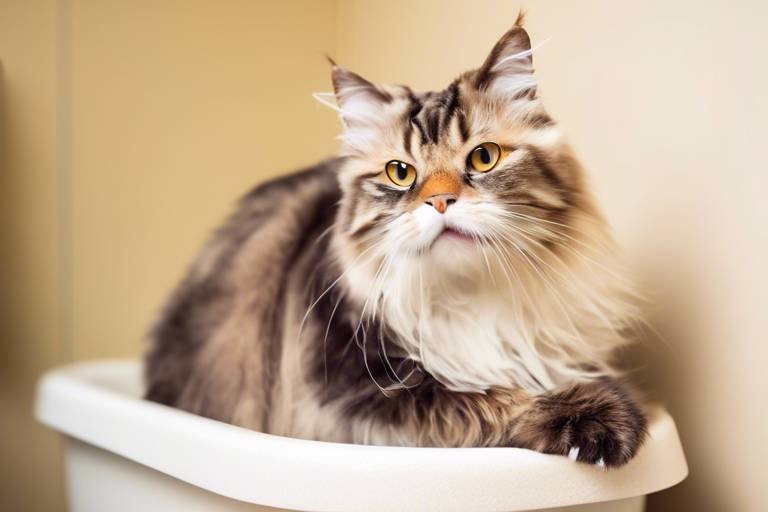Understanding Senior Pet Mobility Aids
As our beloved pets age, they often face mobility challenges that can significantly impact their quality of life. Just like humans, senior pets may experience arthritis, muscle weakness, or other health issues that limit their ability to move freely. This is where mobility aids come into play. These aids are designed to support our furry friends, helping them regain their independence and enjoy their daily activities. In this article, we will explore the various types of mobility aids available, their benefits, and tips for choosing the right one for your senior pet.
Mobility aids are essential tools for senior pets. They not only help alleviate discomfort but also enable older animals to move around more freely and safely. Imagine a once-active dog that now struggles to get up or walk; this can lead to frustration and a decline in their overall well-being. By providing the necessary support, mobility aids help pets maintain their independence, allowing them to engage in activities they love, such as playing fetch or simply going for a walk with their owners. Ultimately, these aids can make a world of difference in enhancing the quality of life for aging animals.
There are several types of mobility aids available, and each serves a unique purpose based on the pet's specific mobility challenges. Understanding the different types can help you make an informed decision about what might work best for your furry friend. Here are some common types:
- Pet Wheelchairs: Ideal for pets with severe mobility issues, these provide support for the hind legs, allowing pets to move comfortably.
- Mobility Harnesses: These harnesses offer support for pets with partial mobility, assisting them in walking.
- Slings: Slings help owners lift their pets safely without straining their backs, making it easier to assist pets in and out of vehicles or up stairs.
Pet wheelchairs are specifically designed for pets who have lost significant mobility, particularly in their hind legs. These devices provide the necessary support to allow pets to move around comfortably, maintaining an active lifestyle. Think of a pet wheelchair as a set of wheels for your furry friend, giving them the freedom to explore their surroundings without the burden of their physical limitations.
Using a pet wheelchair can dramatically improve a pet's quality of life. Not only does it enable them to engage in activities they enjoy, but it also plays a crucial role in reducing the risk of further health complications. Pets that can move around comfortably are less likely to experience issues like muscle atrophy or joint stiffness, which can occur when they are sedentary for long periods. By encouraging movement, wheelchairs help maintain their physical health and mental well-being.
When selecting a wheelchair for your pet, it’s essential to consider their size, weight, and specific mobility needs. A proper fit is crucial to ensure comfort and effectiveness. You want to avoid a wheelchair that is too tight or too loose, as both can cause discomfort and hinder mobility. Many manufacturers offer adjustable options, so you can customize the fit to your pet's unique shape. Remember, a well-fitted wheelchair can make all the difference in your pet's ability to enjoy life.
Mobility harnesses and slings are excellent choices for pets with partial mobility challenges. These aids provide the necessary support to help pets walk, making it easier for them to get around without putting too much strain on their bodies. Additionally, they allow pet owners to lift their furry friends safely, preventing injury to both the pet and the owner. Think of these aids as a gentle helping hand, allowing pets to maintain their dignity while receiving the support they need.
Incorporating mobility aids into your senior pet's life can enhance their overall well-being in several ways. Firstly, these aids promote physical activity, which is vital for maintaining muscle strength and joint flexibility. Secondly, they help reduce pain, as pets can move more freely without the discomfort associated with their conditions. Lastly, increased engagement with their environment can significantly improve a pet's mental health, reducing feelings of isolation or depression that can accompany aging.
By providing support and stability, mobility aids can help senior pets enjoy their daily activities, leading to a happier and healthier life as they age. Imagine your pet being able to trot around the yard again or enjoy a leisurely stroll in the park. These small joys can have a profound impact on their happiness and overall well-being.
Mobility aids also play a critical role in minimizing the risk of falls and injuries. As pets age, their balance and strength may decline, making them more susceptible to accidents. By using mobility aids, pets can navigate their surroundings safely and confidently, which is vital for their health. Just like a safety net for a tightrope walker, mobility aids provide the support that helps prevent mishaps and ensures your pet can enjoy their environment without fear.
1. How do I know if my pet needs a mobility aid?
If your pet is showing signs of difficulty getting up, walking, or maintaining balance, it may be time to consider a mobility aid. Observing changes in their behavior or activity levels can also be a key indicator.
2. Are mobility aids safe for my pet?
Yes, when properly fitted and used, mobility aids are safe for pets. It's essential to follow the manufacturer's guidelines and consult with your veterinarian for tailored advice.
3. Can my pet adjust to using a wheelchair or harness?
Many pets can adjust to using mobility aids with time and patience. Gradual introduction, positive reinforcement, and practice can help your pet feel comfortable and confident.

The Importance of Mobility Aids
This article explores various mobility aids for senior pets, discussing their importance, types, benefits, and tips for choosing the right aid to enhance the quality of life for aging animals.
As our beloved furry friends grow older, they often face challenges that can limit their mobility. This is where mobility aids come into play. These aids are not just tools; they are lifelines that help senior pets maintain their independence and overall quality of life. Imagine how difficult it would be for a pet to navigate their home or yard if they could barely move! Mobility aids help alleviate discomfort and enable older animals to move around more freely and safely.
One of the most significant benefits of mobility aids is the enhanced independence they provide. Senior pets can often feel frustrated when they can’t keep up with their younger counterparts or their favorite activities. With the right mobility aid, they can participate in family activities, enjoy walks, or simply explore their environment without the fear of falling or getting stuck. This sense of independence is crucial for their mental well-being.
Moreover, mobility aids come in various forms, each tailored to meet different needs. For instance, pet wheelchairs are fantastic for those with severe mobility issues, while harnesses and slings can provide support for pets that still have some strength but need a little extra help. The key is to choose the right aid that matches the pet's specific mobility challenges. Understanding these needs can empower pet owners to make informed decisions that significantly improve their pet's quality of life.
In addition to promoting mobility, these aids also play a vital role in reducing pain associated with movement. Many senior pets suffer from arthritis or other joint issues, making every step a painful experience. Mobility aids can help distribute weight more evenly, reducing stress on sore joints and allowing pets to move with less discomfort. This not only enhances their physical health but also contributes to their emotional well-being.
Lastly, it’s essential to recognize that mobility aids can help prevent injuries. As pets age, their coordination and balance can decline, increasing the risk of falls and accidents. By using mobility aids, pets can navigate their surroundings safely and confidently. This is especially important in homes with stairs or slippery floors, where the risk of injury is heightened.
In summary, mobility aids are not merely accessories; they are essential tools that significantly enhance the lives of senior pets. They promote independence, reduce pain, and prevent injuries, allowing our aging companions to enjoy their golden years to the fullest.
- What are mobility aids for pets? Mobility aids are devices designed to assist pets with mobility challenges, helping them move around more easily and safely.
- How do I know if my pet needs a mobility aid? Signs that your pet may need a mobility aid include difficulty walking, reluctance to move, or signs of pain when moving.
- What type of mobility aid is best for my pet? The best type of mobility aid depends on your pet’s specific needs, including their size, weight, and mobility challenges.
- Can mobility aids improve my pet's quality of life? Yes! Mobility aids can significantly enhance your pet's quality of life by promoting independence and reducing discomfort.

Types of Mobility Aids
When it comes to ensuring our beloved senior pets maintain their mobility and independence, understanding the various types of mobility aids available is crucial. These aids are designed to cater to different levels of mobility challenges that aging pets may face. From harnesses to wheelchairs, each type serves a unique purpose and can significantly enhance the quality of life for our furry companions.
One of the most popular options is the pet wheelchair. These specially designed devices are perfect for pets who have lost strength in their hind legs or have other severe mobility issues. They provide the necessary support to help pets move around comfortably, allowing them to maintain an active lifestyle. Imagine your pet zooming around the yard again, tail wagging with joy—this is the magic a wheelchair can bring!
Another great option is the mobility harness. These harnesses are typically used for pets that still have some mobility but need a little extra support. They come with handles that allow pet owners to assist their furry friends in walking or getting up. This is particularly beneficial for pets recovering from surgery or those with arthritis. With a mobility harness, you can help your pet navigate their environment without straining your back. It's like being their personal cheerleader, helping them conquer the world, one step at a time!
For pets that require more assistance, slings can be an excellent choice. Slings are designed to support the pet’s body while allowing the owner to lift and carry them with ease. They are especially useful for pets who may struggle to stand for long periods or need a little boost to get up stairs or into the car. Using a sling can make outings more enjoyable for both you and your pet, as it alleviates the stress of mobility challenges.
In summary, the types of mobility aids available for senior pets can be categorized as follows:
| Type of Mobility Aid | Description | Best For |
|---|---|---|
| Pet Wheelchairs | Supports hind legs, allowing pets to move freely. | Pets with severe mobility issues. |
| Mobility Harnesses | Provides support for walking and lifting. | Pets with partial mobility. |
| Slings | Supports the pet’s body while lifting. | Pets needing assistance getting up or moving. |
Choosing the right mobility aid for your senior pet can feel overwhelming at first, but understanding the options available can make the process easier. Each aid serves a specific purpose, and it’s essential to consider your pet’s unique needs. By doing so, you can help your furry friend maintain a sense of independence and continue to enjoy life to the fullest.
- What is the best mobility aid for my senior pet? The best aid depends on your pet's specific mobility challenges. Consult with your veterinarian to determine the most suitable option.
- How do I measure my pet for a wheelchair? Measure your pet's height, weight, and body length. Many manufacturers provide guidelines for proper sizing.
- Can my pet use a mobility aid indoors? Yes! Many mobility aids are designed for both indoor and outdoor use, making it easier for your pet to navigate their home.
Pet Wheelchairs
When it comes to providing mobility solutions for our beloved furry companions, stand out as one of the most effective options available. Designed specifically for pets suffering from severe mobility issues, these innovative devices are a game-changer in enhancing the quality of life for senior animals. Imagine a once-active dog struggling to get up and move around; a pet wheelchair can transform that struggle into a newfound freedom. With the right wheelchair, your pet can once again chase after their favorite toy or enjoy a leisurely stroll in the park.
Pet wheelchairs come in various designs and sizes, catering to the unique needs of different animals. They typically consist of a frame that supports the pet's hind legs while allowing the front legs to move freely. This design not only aids in mobility but also helps maintain muscle strength and joint health. For example, a dog with degenerative myelopathy or arthritis can benefit immensely from a wheelchair, as it alleviates pressure on sore joints while promoting movement. Not only does this keep them physically active, but it also contributes to their mental well-being, as they can engage more with their surroundings.
One of the most appealing features of pet wheelchairs is the level of customization available. Owners can choose from various sizes, materials, and designs to find the perfect fit for their pet. Additionally, many wheelchairs are adjustable, allowing for growth or changes in the pet's condition over time. When selecting a wheelchair, it's essential to consider factors like your pet's size, weight, and specific mobility challenges. A well-fitted wheelchair can make all the difference in ensuring comfort and effectiveness.
Here’s a quick overview of the different types of pet wheelchairs:
| Type | Description |
|---|---|
| Rear Wheelchair | Supports the hind legs, allowing for natural movement with front legs. |
| Front Wheelchair | Assists pets with front leg issues, providing support for the front end. |
| All-Terrain Wheelchair | Designed for outdoor use, with larger wheels for better maneuverability. |
Using a pet wheelchair can significantly improve your furry friend's life. Not only does it allow them to engage in activities they enjoy, but it also fosters independence, which is crucial for their happiness. Imagine seeing your pet's tail wagging with excitement as they navigate through the yard, exploring their favorite spots once again. It's moments like these that remind us of the importance of investing in the right mobility aids.
In conclusion, pet wheelchairs are invaluable tools for enhancing the lives of senior pets facing mobility challenges. With the right support, your furry friend can enjoy their golden years with dignity and joy, proving that age is just a number when it comes to adventure. So, if you notice your pet struggling to get around, consider a wheelchair as a viable option to help them regain their zest for life.
- How do I know if my pet needs a wheelchair? If your pet is having difficulty walking, shows signs of pain when moving, or has been diagnosed with a mobility-limiting condition, it may be time to consider a wheelchair.
- Can all pets use wheelchairs? While many pets can benefit from a wheelchair, it's essential to consult with your veterinarian to determine the best option based on your pet's specific needs.
- How do I fit my pet for a wheelchair? Proper fitting involves measuring your pet's height, weight, and body length. Many manufacturers provide fitting guides to help you find the right size.
Benefits of Pet Wheelchairs
This article explores various mobility aids for senior pets, discussing their importance, types, benefits, and tips for choosing the right aid to enhance the quality of life for aging animals.
Mobility aids are essential for senior pets to maintain their independence and quality of life. They help alleviate discomfort and enable older animals to move around more freely and safely.
There are several types of mobility aids available, including harnesses, slings, and wheelchairs. Each type serves different needs based on the pet's specific mobility challenges.
Pet wheelchairs are designed for pets with severe mobility issues. They provide support for hind legs, allowing pets to move around comfortably while maintaining an active lifestyle.
Using a pet wheelchair can significantly improve a pet's quality of life, enabling them to engage in activities they enjoy and reducing the risk of further health complications. Imagine seeing your furry friend, who once struggled to move, now zooming around the yard with newfound freedom! Pet wheelchairs are not just about mobility; they are about restoring joy and independence. Here are some key benefits:
- Enhanced Mobility: Wheelchairs allow pets to explore their environment, which is crucial for their physical and mental stimulation.
- Increased Activity Levels: With the support of a wheelchair, pets can engage in play and exercise, helping to maintain their overall health.
- Reduced Pain: By providing proper support, wheelchairs can alleviate strain on the back and joints, reducing discomfort during movement.
- Improved Social Interaction: Pets in wheelchairs can interact more with other animals and people, fostering social bonds and reducing feelings of isolation.
Moreover, the use of a wheelchair can lead to better weight management. When pets are able to move around more freely, they tend to burn more calories, which can help prevent obesity-related health issues. It's like giving them a second chance at being a playful puppy or kitten!
Selecting the appropriate wheelchair involves considering the pet's size, weight, and specific mobility needs. Proper fitting is crucial to ensure comfort and effectiveness. A poorly fitted wheelchair can lead to discomfort or even injuries, so it's essential to consult with a veterinarian or a pet mobility specialist. Visualize this: just as you wouldn’t wear shoes that are too tight or too loose, your pet deserves a wheelchair that fits just right!
Mobility harnesses and slings offer support for pets with partial mobility. They assist in walking and help owners lift their pets safely without straining their backs.
Mobility aids can enhance a senior pet's overall well-being by promoting physical activity, reducing pain, and improving mental health through increased engagement with their environment.
By providing support and stability, mobility aids can help senior pets enjoy their daily activities, leading to a happier and healthier life as they age.
Mobility aids also minimize the risk of falls and injuries, ensuring that pets can navigate their surroundings safely and confidently, which is vital for their health.
Q1: How do I know if my pet needs a wheelchair?
A1: If your pet struggles to walk or shows signs of discomfort while moving, it may be time to consider a wheelchair. Consult your veterinarian for a proper assessment.
Q2: Are pet wheelchairs adjustable?
A2: Yes, most pet wheelchairs are adjustable to accommodate your pet's size and specific needs. Proper fitting is essential for comfort and effectiveness.
Q3: Can all pets use wheelchairs?
A3: While many pets can benefit from wheelchairs, those with certain medical conditions may not be suitable candidates. Always consult with your veterinarian.
Q4: How long can my pet use a wheelchair each day?
A4: The amount of time varies by pet, but it’s generally recommended to start with short periods and gradually increase as your pet becomes more comfortable.
Choosing the Right Wheelchair
When it comes to for your senior pet, it can feel a bit overwhelming at first. After all, our furry friends deserve the best, especially when they’re facing mobility challenges. The first step is to assess your pet’s specific needs. Consider their size, weight, and the extent of their mobility issues. A wheelchair that fits poorly can cause discomfort or even exacerbate existing problems, so proper fitting is crucial.
One of the most important factors to consider is the measurements. You’ll want to take the following measurements:
- Height: Measure from the ground to the top of your pet’s back while they are standing.
- Length: Measure from the front of their chest to the back of their hips.
- Weight: Knowing your pet's weight is essential for selecting a wheelchair that can support them adequately.
Next, think about the design of the wheelchair. Some models are designed for pets who have lost mobility in their hind legs, while others may provide support for both the front and back. Additionally, look for features such as adjustable straps, lightweight materials, and durable wheels that can handle various terrains. This will ensure that your pet can move around comfortably, whether they are navigating your home or enjoying a stroll in the park.
Another aspect to consider is the level of support your pet needs. If they can still walk a bit but struggle with longer distances, a wheelchair that allows for partial weight-bearing might be ideal. On the other hand, if they have lost most of their mobility, a full-support wheelchair would be necessary. It’s also a good idea to consult with your veterinarian. They can provide insights into your pet's specific condition and recommend the best type of wheelchair based on their medical needs.
Finally, don’t forget about your pet's comfort! Look for wheelchairs with padded harnesses and adjustable components. You want to ensure that your furry friend feels secure and comfortable while using their new mobility aid. After all, a happy pet is a healthy pet, and the right wheelchair can make all the difference in enhancing their quality of life.
Here are some common questions pet owners have when considering mobility aids for their senior pets:
- How do I know if my pet needs a wheelchair? If your pet struggles to walk, frequently falls, or shows signs of discomfort while moving, it may be time to consider a wheelchair.
- Can my pet get used to a wheelchair? Yes! With time and patience, most pets can adapt to using a wheelchair. Start with short sessions and gradually increase the duration.
- Are there any special maintenance tips for pet wheelchairs? Regularly check for wear and tear, clean the wheels, and ensure that all straps are secure and in good condition.
Mobility Harnesses and Slings
When it comes to enhancing the mobility of our beloved senior pets, stand out as indispensable tools. These aids are particularly beneficial for pets experiencing partial mobility issues, whether due to age-related ailments, injuries, or chronic conditions. Imagine trying to walk with a heavy backpack that keeps slipping off your shoulders; that’s how your pet might feel without the right support. Mobility harnesses and slings provide that extra layer of security, allowing your furry friend to navigate their world with confidence.
One of the primary advantages of using a mobility harness is that it allows you to assist your pet without straining your back. Picture this: you’re trying to help your dog up the stairs, but their legs aren’t cooperating. With a harness, you can gently lift them without risking injury to yourself or discomfort to them. These harnesses distribute weight evenly, making it easier for both you and your pet to move around. They come in various styles, from full-body support to simple lifting straps, catering to the specific needs of your pet.
Slings, on the other hand, are perfect for pets that need a little more help. They are typically designed to support the belly and rear end of the pet, allowing you to carry them safely. Think of it as a cozy hammock that cradles your pet while you help them walk. This option is especially useful for pets with arthritis or those recovering from surgery, as it minimizes the strain on their joints. With a sling, you can take your pet for a short walk or even just around the house, ensuring they stay active without overexerting themselves.
When selecting a mobility harness or sling, it’s crucial to consider a few factors:
- Size and Fit: Ensure that the harness or sling fits snugly but comfortably. An ill-fitting harness can cause chafing or discomfort.
- Material: Look for breathable, durable materials that can withstand regular use while being gentle on your pet’s skin.
- Ease of Use: Choose a design that’s easy for you to put on and take off, as well as comfortable for your pet.
In conclusion, mobility harnesses and slings are not just aids; they are lifelines that allow senior pets to maintain their independence and enjoy their golden years. By providing the necessary support, you’re not only improving their mobility but also enhancing their overall quality of life. After all, every wag of the tail and purr of contentment is a testament to the joy these aids can bring!

Benefits of Using Mobility Aids
When it comes to our beloved senior pets, maintaining their quality of life is paramount. Mobility aids play a crucial role in this aspect, serving as lifelines that bridge the gap between discomfort and freedom. Imagine how it feels to struggle with movement—just like us, pets can experience frustration and sadness when they can't engage in their favorite activities. Mobility aids are designed to enhance their independence, allowing them to navigate their surroundings with confidence and ease.
One of the most significant benefits of using mobility aids is the promotion of physical activity. Older pets often face challenges that discourage them from moving around, leading to a sedentary lifestyle. This inactivity can result in weight gain, muscle atrophy, and a decline in overall health. By incorporating mobility aids, pets can enjoy their daily walks or play sessions without the constant fear of falling or getting hurt. It's like giving them a second chance at their youthful exuberance!
Moreover, mobility aids can significantly reduce pain and discomfort. Many senior pets suffer from conditions like arthritis or hip dysplasia, which can make movement painful. A well-fitted harness or wheelchair can alleviate some of this discomfort by redistributing weight and providing support where it's needed most. This not only helps in managing pain but also encourages pets to be more active, creating a positive feedback loop of movement and well-being.
Another important aspect is the mental health benefits that come with increased mobility. Pets are social creatures; they thrive on interaction with their humans and their environment. When they can move freely, they are more likely to engage in playful behavior, explore their surroundings, and interact with family members. This stimulation is essential for their mental health, reducing the risk of depression and anxiety that often accompanies aging.
It's also worth mentioning that mobility aids can help in reducing injury risks. Senior pets are more susceptible to falls and injuries, which can lead to serious health complications. By providing the necessary support, mobility aids can help prevent accidents, allowing pets to navigate their homes and yards safely. Think of it as a safety net that allows our furry friends to remain adventurous without the fear of falling.
In addition to these benefits, using mobility aids can also foster a stronger bond between pets and their owners. When you see your pet thriving and enjoying life again, it brings immense joy and satisfaction. It's a reminder of the love and care that you provide. In many cases, the simple act of helping a pet with mobility challenges can deepen the relationship, as they rely on you for support and companionship.
In summary, the benefits of using mobility aids for senior pets are multifaceted. They not only enhance physical activity and reduce pain but also improve mental health and safety. Investing in the right mobility aid is an investment in your pet's happiness and well-being. So, why wait? Consider how a mobility aid might change your furry friend's life for the better!
- What types of mobility aids are available for senior pets?
There are various mobility aids including wheelchairs, harnesses, and slings, each designed to meet specific needs. - How do I know if my pet needs a mobility aid?
If your pet shows signs of struggling to walk or maintain balance, or if they seem to avoid movement, it may be time to consider a mobility aid. - Can mobility aids help with my pet's pain?
Yes, many mobility aids are designed to alleviate discomfort by providing support and stability, helping to manage pain levels effectively. - How do I choose the right mobility aid?
Consider your pet's size, weight, and specific mobility challenges. Proper fitting is crucial for comfort and effectiveness.
Improving Quality of Life
When it comes to our beloved senior pets, their quality of life is paramount. As they age, mobility can become a significant challenge, but fortunately, mobility aids can play a transformative role in enhancing their daily experiences. Imagine your furry friend, once lively and playful, now struggling to get up or move around. This is where mobility aids step in, acting as a bridge to restore their independence and joy.
Using mobility aids, such as wheelchairs or harnesses, can drastically improve a senior pet's ability to engage in activities they once loved. Whether it's a stroll in the park or a simple game of fetch in the backyard, these aids help them participate in life, rather than merely existing in it. Think of it as giving them a second chance to enjoy the world around them, much like a child getting their first bicycle. The thrill, the freedom, and the sheer joy of movement can reignite their spirit.
Moreover, these aids not only assist with mobility but also provide emotional benefits. Pets are social creatures, and when they can move around comfortably, they are more likely to engage with their family members and other pets. This interaction is crucial for their mental health, as it helps combat feelings of isolation and depression that can often accompany aging. Just like us, pets thrive on companionship and activity, and mobility aids can ensure they don’t miss out.
Let’s not forget the physical benefits as well. Regular movement, even if assisted, can help maintain muscle tone and joint health. It’s like giving them a gentle workout that keeps their bodies functioning optimally. For instance, a pet wheelchair allows for natural movement patterns, which can help prevent stiffness and further health complications. It’s essential to keep their bodies active to support their overall health.
Incorporating mobility aids into a senior pet's routine can also lead to a more structured lifestyle. With the right support, pet owners can establish a daily routine that includes regular walks or playtime. This structure not only benefits the pet but also provides the owner with a sense of purpose and fulfillment. After all, seeing your pet happy and engaged is one of the most rewarding experiences a pet owner can have.
In summary, improving the quality of life for senior pets through mobility aids is about more than just physical support; it's about enhancing their overall well-being. By enabling them to move freely, engage socially, and maintain their health, we can ensure that their golden years are filled with joy and vitality. So, if you notice your furry friend struggling, consider mobility aids as a valuable investment in their happiness and health.
- What types of mobility aids are available for senior pets? There are various aids such as wheelchairs, harnesses, and slings designed to cater to different mobility challenges.
- How do I know if my pet needs a mobility aid? If your pet is struggling to walk, frequently falls, or shows signs of discomfort while moving, it may be time to consider a mobility aid.
- Can mobility aids help with my pet's emotional well-being? Absolutely! Mobility aids allow pets to engage more with their environment and loved ones, which can significantly improve their mood and reduce feelings of isolation.
- How do I choose the right mobility aid for my pet? Consider your pet's size, weight, and specific mobility needs. It's essential to ensure a proper fit for comfort and effectiveness.
Reducing Injury Risks
As our beloved pets age, their bodies undergo significant changes that can make them more susceptible to injuries. This is where mobility aids come into play, acting as a safety net that not only supports their physical movement but also significantly reduces the risk of falls and injuries. Imagine a world where your senior pet can confidently navigate their home without the fear of slipping or stumbling. Sounds great, right? Mobility aids can turn that dream into a reality!
One of the primary benefits of using mobility aids is their ability to provide stability and support. For example, consider a pet wheelchair designed for dogs with weakened hind legs. With the proper support, these pets can move around freely, reducing the likelihood of accidents that could lead to serious injuries. Similarly, mobility harnesses and slings can help owners lift their pets safely, preventing strain on both the pet and the owner. This is crucial, especially for larger breeds where lifting can be a significant challenge.
Moreover, mobility aids can enhance a pet's awareness of their surroundings. When pets feel stable and secure, they are more likely to explore their environment, which can help maintain their mental agility. Think of it like a toddler learning to walk with the help of a sturdy handrail; the more confident they feel, the more they can explore their world. This exploration is vital for senior pets, as it keeps them engaged and can even delay the onset of cognitive decline.
In addition to physical support, mobility aids can also improve a pet's overall confidence. When a pet knows they have the necessary support to move around, they are less likely to hesitate or become anxious about their mobility. This newfound confidence can lead to more active participation in family activities, whether it's a leisurely stroll in the park or simply moving around the house. Pets that are more active are less likely to experience the negative effects of a sedentary lifestyle, such as obesity or muscle atrophy, which can further complicate their health.
To illustrate the impact of mobility aids on injury reduction, consider the following table:
| Type of Mobility Aid | Injury Risk Reduction | Additional Benefits |
|---|---|---|
| Pet Wheelchairs | Minimizes falls and supports hind legs | Encourages movement and play |
| Mobility Harnesses | Prevents strain during lifting | Improves owner-pet bonding |
| Slings | Provides support for weak limbs | Facilitates safe outdoor experiences |
In summary, investing in mobility aids not only enhances your senior pet's quality of life but also plays a crucial role in . By providing them with the necessary support, you can ensure they remain active, engaged, and happy in their golden years. After all, a little help goes a long way in keeping your furry friend safe and sound!
- What are the signs my pet needs a mobility aid? Look for signs such as difficulty standing, reluctance to walk, or frequent falls.
- How do I choose the right mobility aid? Consider your pet's size, weight, and specific mobility challenges. It's essential to consult with a veterinarian for personalized advice.
- Can mobility aids be used indoors and outdoors? Yes, many mobility aids are designed for both environments, but ensure they are suitable for the surfaces your pet will encounter.
- How can I help my pet adjust to using a mobility aid? Introduce the aid gradually, using positive reinforcement and patience to encourage your pet to explore and use it.
Frequently Asked Questions
- What are mobility aids for senior pets?
Mobility aids are supportive devices designed to help senior pets maintain their independence and mobility. These aids can include harnesses, slings, and wheelchairs, each catering to specific mobility challenges faced by aging animals.
- Why are mobility aids important for senior pets?
As pets age, they may experience decreased mobility due to arthritis, injuries, or other health issues. Mobility aids are crucial as they help alleviate discomfort, reduce the risk of falls, and enable pets to move around more freely, enhancing their overall quality of life.
- What types of mobility aids are available?
There are several types of mobility aids available, including:
- Pet wheelchairs for severe mobility issues
- Mobility harnesses for partial support
- Slings for lifting pets safely
- How do pet wheelchairs benefit senior pets?
Pet wheelchairs provide essential support for pets with severe mobility challenges, allowing them to move comfortably and engage in activities they love. This can significantly improve their quality of life and reduce the risk of additional health complications.
- What should I consider when choosing a mobility aid?
When selecting a mobility aid, consider your pet's size, weight, and specific mobility needs. Proper fitting is crucial to ensure comfort and effectiveness, so it's essential to consult with a veterinarian or a pet mobility specialist.
- Can mobility aids improve my pet's mental health?
Absolutely! Mobility aids can enhance a senior pet's mental health by promoting physical activity and allowing them to engage more with their environment. This increased activity can lead to a happier and more fulfilled life as they age.
- How do mobility aids reduce the risk of injuries?
Mobility aids help minimize the risk of falls and injuries by providing stability and support. This is especially important for senior pets, as navigating their surroundings safely can prevent accidents and ensure they remain healthy and active.



















